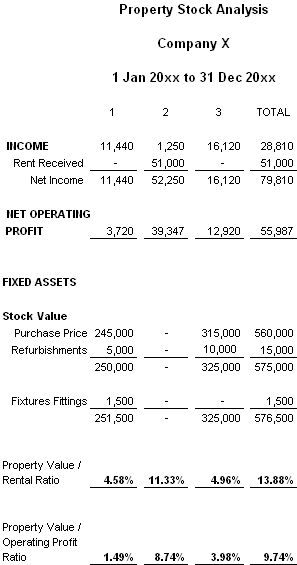Help
Property Stock Analysis
By combining company X's profit and loss statement and its balance sheet we are able to do property stock analysis. Property stock is based on the purchase price of a property and the cost of any refurbishments. The costs of fixtures and fittings is generally not included unless these costs are significant.

Property Value to Rent/Sales Ratio
property 1, which is valued at $250,000, generates a rental income of $11,440 or 4.58% of its value
property 2, which is valued at $450,000, generated a sales income of $51,000 or 11.33% of its value
property 3, which is valued at $325,000, generates a rental income of $16,120 or 5.12% of its value
The average ratio for all properties is 7.01%
Property Value to Operating Profit Ratio
property 1, valued at $250,000, generates an operating profit of $3,720 or 1.52% of its value
property 2, valued at $450,000, generated an operating profit of $39,347 or 8.74% of its value
property 3, at $325,000, generates a rental income of $12,920
or 4.10% of its value
The average ratio for all properties is 4.79%. This does not consider any overheads.
Capital Asset Pricing Model (CAPM)
These figures have implications for the company X's Capital Asset Pricing Model (CAPM). If the percentage return of a risk free investment such as a government bond is 4% then property 1 would not be a viable investment as it only generates 1.49% in property value to rent/sales ratio. The direct costs of this property would to have be signficantly reduced as the property value to rent/sales ratio is only 4.58%. The same would not apply to property 2 which has a property value to rent/sales ratio of 11.33% and a property value to operating profit ratio of 8.74%. However, this will not be sustained as the property 2 has now been removed from company X's property portfolio. Of the remaining properties, property 3 is a more viable investment than property 1 due to its comparatively higher rent/sales ratio of 4.96% and a property value to operating profit ratio of 3.98%. However, the latter is only marginally higher than a risk free investmnent of 4%. And this will be eroded when apportioning overheads.
Though the company X's property stock as a whole gives at higher return than a risk free investment at a property value to rent/sales ratio at 13.88% and a property value to operating profit ratio at 9.74%, neither will be sustained as the most profitable property, 2, has been removed from the property stock. In sum, company X's property investment portfolio is in need of restructing to compare favourably with risk free investments.
Related Topics
Group Property Company Profit and Loss Statements
Group Property Company Balance Sheets
Group Company Property Stock Analysis
Property Company Profit and Loss Statements
Property Company Balance Sheets
|
